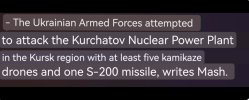Saatat jopa olla oikeassa, on niin paljon mitä me ei tällä palstalla tiedetä!Tässä taitaa olla hiljainen aselepo. Ukraina ei tiputa Venäjällä siltoja eikä Venäjä Ukrainassa rintaman ulkopuolella. Molemmat tarvitsevat niitä siviilipuolen hommiin.
Install the app
How to install the app on iOS
Follow along with the video below to see how to install our site as a web app on your home screen.
Note: This feature may not be available in some browsers.
You are using an out of date browser. It may not display this or other websites correctly.
You should upgrade or use an alternative browser.
You should upgrade or use an alternative browser.
Ukrainan konflikti/sota
RKSTAK
Ylipäällikkö
Ukrainalla on droneja joilla on kantavuus 2500km ja jotka on tuotannossa ja operaatiovalmiudessa.
Aika hurjat kantamat kyllä jos tekniikka pelittää. Noillahan pystyy iskemään Uralia myöten kaikkiin lentotukikohtiin. Häivettä mukaan niin aika rauhassa saavat syrjäisempiä reittejä lennellä.
Tossa vielä patkää niistä Romanian vapaaehtoisista:
Antares
Respected Leader
Mahdollisesti mielenkiintoista:
Throughout the war Russia has lost (visually confirmed) tanks and IFV/APCs at an average ratio of 1:1.87 (red line)
The monthly ratio (blue line) has varied around that but not by that much, from 1:1.47 to 1:2.21, but this month it has shot up to 1:3.49 way above its normal range.
I don't know why this is
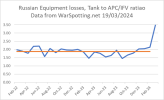
Here is my data table of all Russian losses so you can check my maths and a graph of those same losses, to help visualise the changes. All of the data is from the website http://Warspotting.net

Looking at the tank losses by type, we see a surprise drop in the % of T-80s to 25% of the total, which is less than any month since April 2022, but it's not that dramatic compared to the overall ratio change.
'New' T-90s have increased slightly, and very old T-62 & T-55s are above average, but again not that dramatically.
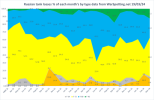
Looking at Russian IFV/APC losses, of which there have been 129 Visually confirmed in March so far. we do not see any significant change, there is a modest increase in BTR-82 losses, but it's not that big.

Looking at comments on the first post in this thread, Russia was losing 1.87 IFVs for each Tank it lost, and now it is losing even more 3.49 IFVs for each tank it loses. Hope that helps.
Also, here are the data tables for both Tank Losses and IFV. In all cases, the data is from http://warspotting.net
Linkki viestiin jossa IFV+APC sekä panssarivaunujen numerot: LINKKI
-
Kommenteista yksi kysymys: My follow up question to this data is: "Is the ratio shift due to an increase in IFV/APC losses, a decrease in tank losses, or both?"I don't have the time to check right now. But if I remember I'll look at the trend lines for loss quantities later today and follow up.
Johon Richard Vereker vastasi näin: Compared to recent months at this point there are more IFVs and less Tanks, so a bit of both.
-
Kommenteista löytyi myös tämä viesti: I calculated the proportions of tank losses to AFV+IFV+APC in other sources and got the following results: GSUA 1:2.31; Oryx 1:2,63; @AndrewPerpetua 1:3,10. It cannot be denied that the number of lost armored vehicles is definitely increasing.
-
Ukrainan ilmoitusten mukaan suhdeluku ei ole muuttunut merkittävästi, mutta Oryxin numero on suurehko. Sen sijaan Andrew Perpetua ja Warspotting datan mukaan ollaan selvästi yli 1:3.
Vaikuttaa siltä että maaliskuu 2024 on poikkeava tämän tappioiden suhdeluvun osalta.
Sitä voi selittää erilainen kaluston ja joukkojen käyttö - tai sitten tietyn kaluston käytön estäminen (mahdollisesti tulevaa käyttöä varten). Toisaalta jos panssarivaunuja säästeltäisiin, miksei samalla säästettäisi IFV+APC ajoneuvoja? Näiden on tarkoitus tukea toisiaan.
Yksi vaihtoehto on tietysti se että panssarivaunujen korjaamisen, kunnostamisen ja aktivoinnin kanssa on alkanut olla ongelmia, mistä syystä niitä on käytetty vähemmän ja samalla niiden tappiot ovat suhteessa vähäisempiä.
Toki myös käytettävissä oleva datamäärä voi hämätä tai vääristää kuvaa.
Mielenkiintoista seurata, mihin suuntaan tämä kehittyy kevään ja kesän aikana. Kenties tämä on yksittäinen poikkeus eikä uusi normaali - tai kenties ei.
-
MUOKKAUS: puolalainen Marek Meissner kirjoitti näin 13.3.2024:
Two things: firstly, the production of the T-90M is unknown. Estimates range from 10 to 30 copies per month, but probably closer to the first number; in January, Moscow TV showed an echelon of tanks that "left the factory gate this month" and there were 12 T-90Ms.
Mainly T-80s of all variants are being restored because there were the most of them in warehouses and they were in the best condition. And there are a lot of engines and transmissions. But as photos of the deep storage warehouse near Moscow show, such vehicles for revitalization are already running out.
The Russians have a big problem with T-72s of all versions - a lot of them are in warehouses everywhere, they could be restored. But there are no engines of the W-46 series or in mob warehouses. not in deep storage, anywhere.
The problem is so urgent that they tried to look for engines from former customers and about a hundred were imported from African countries and the Maghreb. And that was the end, the spring for the Russians dried up.
Even the Duma Defense Committee faced this problem, and the industry was asked whether it would resume production of W-46. But the industry cannot provide "incomplete documentation", and there is no point in doing so
-
Hänen viestinsä oli vastaus tähän:
CNN reports, quoting intelligence workers, that Russia is currently "producing" about 125 tanks a month, but the vast majority of them (86 %) are only tanks returned to service, taken out of warehouses and refurbished damaged during combat. And although Russia still stores approximately 5,000 tanks, "a large proportion of them are probably beyond repair and suitable only for disassembly for parts."And that's why T-62M and T-54/55 will appear more and more often.
Throughout the war Russia has lost (visually confirmed) tanks and IFV/APCs at an average ratio of 1:1.87 (red line)
The monthly ratio (blue line) has varied around that but not by that much, from 1:1.47 to 1:2.21, but this month it has shot up to 1:3.49 way above its normal range.
I don't know why this is

Here is my data table of all Russian losses so you can check my maths and a graph of those same losses, to help visualise the changes. All of the data is from the website http://Warspotting.net

Looking at the tank losses by type, we see a surprise drop in the % of T-80s to 25% of the total, which is less than any month since April 2022, but it's not that dramatic compared to the overall ratio change.
'New' T-90s have increased slightly, and very old T-62 & T-55s are above average, but again not that dramatically.

Looking at Russian IFV/APC losses, of which there have been 129 Visually confirmed in March so far. we do not see any significant change, there is a modest increase in BTR-82 losses, but it's not that big.

Looking at comments on the first post in this thread, Russia was losing 1.87 IFVs for each Tank it lost, and now it is losing even more 3.49 IFVs for each tank it loses. Hope that helps.
Also, here are the data tables for both Tank Losses and IFV. In all cases, the data is from http://warspotting.net
Linkki viestiin jossa IFV+APC sekä panssarivaunujen numerot: LINKKI
-
Kommenteista yksi kysymys: My follow up question to this data is: "Is the ratio shift due to an increase in IFV/APC losses, a decrease in tank losses, or both?"I don't have the time to check right now. But if I remember I'll look at the trend lines for loss quantities later today and follow up.
Johon Richard Vereker vastasi näin: Compared to recent months at this point there are more IFVs and less Tanks, so a bit of both.
-
Kommenteista löytyi myös tämä viesti: I calculated the proportions of tank losses to AFV+IFV+APC in other sources and got the following results: GSUA 1:2.31; Oryx 1:2,63; @AndrewPerpetua 1:3,10. It cannot be denied that the number of lost armored vehicles is definitely increasing.
-
Ukrainan ilmoitusten mukaan suhdeluku ei ole muuttunut merkittävästi, mutta Oryxin numero on suurehko. Sen sijaan Andrew Perpetua ja Warspotting datan mukaan ollaan selvästi yli 1:3.
Vaikuttaa siltä että maaliskuu 2024 on poikkeava tämän tappioiden suhdeluvun osalta.
Sitä voi selittää erilainen kaluston ja joukkojen käyttö - tai sitten tietyn kaluston käytön estäminen (mahdollisesti tulevaa käyttöä varten). Toisaalta jos panssarivaunuja säästeltäisiin, miksei samalla säästettäisi IFV+APC ajoneuvoja? Näiden on tarkoitus tukea toisiaan.
Yksi vaihtoehto on tietysti se että panssarivaunujen korjaamisen, kunnostamisen ja aktivoinnin kanssa on alkanut olla ongelmia, mistä syystä niitä on käytetty vähemmän ja samalla niiden tappiot ovat suhteessa vähäisempiä.
Toki myös käytettävissä oleva datamäärä voi hämätä tai vääristää kuvaa.
Mielenkiintoista seurata, mihin suuntaan tämä kehittyy kevään ja kesän aikana. Kenties tämä on yksittäinen poikkeus eikä uusi normaali - tai kenties ei.
-
MUOKKAUS: puolalainen Marek Meissner kirjoitti näin 13.3.2024:
Two things: firstly, the production of the T-90M is unknown. Estimates range from 10 to 30 copies per month, but probably closer to the first number; in January, Moscow TV showed an echelon of tanks that "left the factory gate this month" and there were 12 T-90Ms.
Mainly T-80s of all variants are being restored because there were the most of them in warehouses and they were in the best condition. And there are a lot of engines and transmissions. But as photos of the deep storage warehouse near Moscow show, such vehicles for revitalization are already running out.
The Russians have a big problem with T-72s of all versions - a lot of them are in warehouses everywhere, they could be restored. But there are no engines of the W-46 series or in mob warehouses. not in deep storage, anywhere.
The problem is so urgent that they tried to look for engines from former customers and about a hundred were imported from African countries and the Maghreb. And that was the end, the spring for the Russians dried up.
Even the Duma Defense Committee faced this problem, and the industry was asked whether it would resume production of W-46. But the industry cannot provide "incomplete documentation", and there is no point in doing so
-
Hänen viestinsä oli vastaus tähän:
CNN reports, quoting intelligence workers, that Russia is currently "producing" about 125 tanks a month, but the vast majority of them (86 %) are only tanks returned to service, taken out of warehouses and refurbished damaged during combat. And although Russia still stores approximately 5,000 tanks, "a large proportion of them are probably beyond repair and suitable only for disassembly for parts."And that's why T-62M and T-54/55 will appear more and more often.
Viimeksi muokattu:
Jotain tällästä se oli, nimenomaan "koiratappelua" koittivatten.... se laakase ja unohda ohjuksilla on sitte ihan eri juttu... Sodat on aina kehittäny teknologiaa helvatun nopeesti ja ihmeellisesti, se nähdään nytkin.... Aprikoos, asiasta kukkaruukkuun... Vaikka kuin olis dronet ja kaikki haitekit, niin tossuväki se on kuitenkin, joka alueita pystyy haltuun ottamaan.... Vaikka kuinka monta dronea surisis ilmoilla, eikä mikään pystyis ulkona liikkumaan... niin sillä ei alueita vallata, kun ne pitäs pystyä myös miehittämään ja siihen tarttetaan tossuväkeä... Just siks ryssät on tän jo hävinny... ei niittenkään rahkeet riitä Ukrainaa alistamaan, ku kansa pistää hanttiin... Siinähän miehität, ku kaikki panee vastaan....ja joka kadun kulmalla pitäs olla yks iigori vahissa, ettei ne vaan haluais itsenäisiä olla....Muistan nähneeni juutuupissa jonkun dokkarin aiheesta. Tykeillä käytävässä lähitaistelussa tekoäly oli ylivoimainen koska se ampui suoraan kohtauskurssilla. Ihmislentäjät on opetettu tekemään tykkihyökkäykset viistosti, jotta arviointivirhe ei aiheuttaisi yhteentörmäystä. Jos tykkitaistelu nähdään tärkeänä taistelun osa-alueena, voitaneen tuleviin hävittäjiin integroida tekoäly tekemään tykkihyökkäykset. Lentäjä valitsee maalin ja aseeksi tykin, jolloin tekoäly alkaa ohjata konetta FBW:n kautta ja hoitaa suuntaamisen, ampumisen ja väistöliikkeen.
Käsittääkseni jenkki-ilmavoimien 6. sukupolven miehitetyn hävittäjän olisi tarkoitus toimia hermokeskuksena tekoälyn ohjaamille droneille, jotka pystyvät valaisemaan kohteita, kantamaan ja ampumaan ohjuksia sekä tunkeutumaan ilmatilaan, joka on liian vaarallinen miehitetylle järjestelmälle.
Mielestäni tekoälyä joudutaan vielä kehittämään paljon, jotta se kykene analysoimaan muuttuvia ja monimutkaisia tilanteita ja tekemään oikeita päätöksiä tappavan voiman käytöstä. Dronen ohjelmoiminen lentämään määritellylle alueelle ja iskemään alueen sisällä mihin tahansa tankin/ryssän muotoiseen kohteeseen on paljon helpompaa.
Edit: kontrataan off-topickiksi lipsahtanut postaus juhlistamalla 200 kärähtäneen ryssätankin ylittymistä. 125 tankin kuukausituotannolla (uusiotuotanto ja reaktivointi) on ryssä tässä kuussa 84 tankkia pakkasella.
Katso liite: 95364
Edit 2:02.03.2024 03.03.2024 04.03.2024 https://twitter.com/DefenceU/status/1764529029120467141
05.03.2024 https://twitter.com/DefenceU/status/1764896108017234342
06.03.2024 https://twitter.com/DefenceU/status/1765252206448513300
07.03.2024 https://twitter.com/DefenceU/status/1765617821524853054
08.03.2024 https://twitter.com/DefenceU/status/1765985679429808195
09.03.2024 https://twitter.com/DefenceU/status/1766351464039952672
10.03.2024 https://twitter.com/DefenceU/status/1766703393899254027
11.03.2024 https://twitter.com/DefenceU/status/1767070088530661464
12.03.2024 https://twitter.com/DefenceU/status/1767427646726545481
13.03.2024 https://twitter.com/DefenceU/status/1767795989002301548
14.03.2024 https://twitter.com/DefenceU/status/1768156774798942381
15.03.2024 https://twitter.com/DefenceU/status/1768519378234941783
16.03.2024 https://twitter.com/DefenceU/status/1768881507974656259
17.03.2024 https://twitter.com/DefenceU/status/1769239449047531886
18.03.2024 https://twitter.com/DefenceU/status/1769605039469764886

rty19
Greatest Leader
Antares
Respected Leader
Tatarigami_UA ajatuksia siitä, miten "voitto" voitaisiin saavuttaa:
When discussing strategies for achieving victory, I believe one of the most pragmatic approaches for Ukraine lies in destabilizing Russia's power base, thereby prompting a shift by making this war unprofitable.
Historically, few rulers have maintained power solely through their own efforts, they rely heavily on the support of elites consensus. Such unwritten agreement exists between leaders and elites, wherein those with influence and resources bolster the regime in exchange for obtaining or preserving their own wealth and privileges.
Despite facing Western sanctions, Putin's loyal elites have largely managed to maintain the status quo, with some even increasing their wealth. This perpetuates an unofficial agreement where both sides remain content overall.
In my view, the most effective means of altering this dynamic is to target Russia's key economic assets, a tactic Ukraine partially has begun to employ successfully by attacking oil refineries.
This approach not only disrupts military logistics but also undermines the economic interests of those profiting most from the oil trade.
Intensifying the destruction of strategic assets that yield substantial profits for their owners serves as a potent signal that war is detrimental to business interests. As Ukraine enhances its long-range drone and potentially missile capabilities, the prospect of losing assets, contracts, and facing elevated insurance costs will inevitably lead to conclusion that war is an unprofitable venture for Russia, thereby compelling them to reconsider their stance in future negotiations, if not prompting a shift in power.
The will of the general populace in Russia hold little sway as long as key centers like Moscow and the elites within them can sustain their lifestyle without feeling the toll of war. While this may cause disruptions in global market prices and impact the global economy, in a scenario where Ukraine lacks sufficient aid to decisively end the war in its favor, I see few other practical alternatives.
When discussing strategies for achieving victory, I believe one of the most pragmatic approaches for Ukraine lies in destabilizing Russia's power base, thereby prompting a shift by making this war unprofitable.
Historically, few rulers have maintained power solely through their own efforts, they rely heavily on the support of elites consensus. Such unwritten agreement exists between leaders and elites, wherein those with influence and resources bolster the regime in exchange for obtaining or preserving their own wealth and privileges.
Despite facing Western sanctions, Putin's loyal elites have largely managed to maintain the status quo, with some even increasing their wealth. This perpetuates an unofficial agreement where both sides remain content overall.
In my view, the most effective means of altering this dynamic is to target Russia's key economic assets, a tactic Ukraine partially has begun to employ successfully by attacking oil refineries.
This approach not only disrupts military logistics but also undermines the economic interests of those profiting most from the oil trade.
Intensifying the destruction of strategic assets that yield substantial profits for their owners serves as a potent signal that war is detrimental to business interests. As Ukraine enhances its long-range drone and potentially missile capabilities, the prospect of losing assets, contracts, and facing elevated insurance costs will inevitably lead to conclusion that war is an unprofitable venture for Russia, thereby compelling them to reconsider their stance in future negotiations, if not prompting a shift in power.
The will of the general populace in Russia hold little sway as long as key centers like Moscow and the elites within them can sustain their lifestyle without feeling the toll of war. While this may cause disruptions in global market prices and impact the global economy, in a scenario where Ukraine lacks sufficient aid to decisively end the war in its favor, I see few other practical alternatives.
BarrelNut
Kenraali
Eipä tämä juuri liity ketjun aiheeseen, mutta tekoälyyn pohjautuvat ohjausjärjestelmät, ml. AI-pilotit hävittäjä- ja pommikoneisiin, tulevat varmaan nopeammin kun monet vielä kuvittelevatkaan. Vihollisen taistelijoita ja muita kohteita automaattisesti metsästävät (ilman ohjaaja) dronet ovat luultavasti jo pidemmällä kuin piirustuspöydällä.
Kohta tällaisia on varmaan Ukrainan taivaalla, ellei jo ole. Nämä kyllä tekevät jalkaväen elon todella vaikeaksi!
Autonomisen ajamisen maailmassa AI pystyy ajamaan autoa jo varsin hyvin huomattavan kompleksisessa ympäristössä.
Kohta tällaisia on varmaan Ukrainan taivaalla, ellei jo ole. Nämä kyllä tekevät jalkaväen elon todella vaikeaksi!
Autonomisen ajamisen maailmassa AI pystyy ajamaan autoa jo varsin hyvin huomattavan kompleksisessa ympäristössä.
ryssän IT kyky huomioiden tartte mitään häivettäkään, kyl sinne punaselle torille pääsee vaikka ihan hitaalla kikottimella, kertoili yks Matias.... alkoko se sukunimi ärrällä, tai jotain.....Aika hurjat kantamat kyllä jos tekniikka pelittää. Noillahan pystyy iskemään Uralia myöten kaikkiin lentotukikohtiin. Häivettä mukaan niin aika rauhassa saavat syrjäisempiä reittejä lennellä.
Ukrainalainen kertoilee Belgorodilaisista kavereistaan. Valitettavasti näiden reaktioita ei nähdä, koska ovat estetty. Mutta olisi kyllä melkein mielenkiintoista nähä noiden reaktiot nyt ja jos ukrainalaiset reagois samalla tavoin. "Näyttäkää video, muuten ei ole totta, ja vaikka näyttäisittekin, niin ei uskota, nauttikaa vapauttamisesta."
Oh I forgot!! I had few girl “friends” from Bilgorod before war started. When this hell started they said: don’t worry, just seat at home, russians are saving you. We were in the same chat with girl from Kharkiv, she was sitting in underground few days crying. They had huge street fights and explosions. Bilgorod girls just said: oh, go out and make a video for us, it’s not happening Just want to tell them the same now
rty19
Greatest Leader
Eipä tämä juuri liity ketjun aiheeseen, mutta tekoälyyn pohjautuvat ohjausjärjestelmät, ml. AI-pilotit hävittäjä- ja pommikoneisiin, tulevat varmaan nopeammin kun monet vielä kuvittelevatkaan. Vihollisen taistelijoita ja muita kohteita automaattisesti metsästävät (ilman ohjaaja) dronet ovat luultavasti jo pidemmällä kuin piirustuspöydällä.
Kohta tällaisia on varmaan Ukrainan taivaalla, ellei jo ole. Nämä kyllä tekevät jalkaväen elon todella vaikeaksi!
Autonomisen ajamisen maailmassa AI pystyy ajamaan autoa jo varsin hyvin huomattavan kompleksisessa ympäristössä.
Waymo-firmallahan on jo jonkun aikaa ollut autonominen taksipalvelu neljässä USA:n kaupungissa San Fransisco, Los Angeles, Phoenix ja Austin.

Waymo - Self-Driving Cars - Autonomous Vehicles - Ride-Hail
Waymo—formerly the Google self-driving car project—makes it safe and easy for people & things to get around with autonomous vehicles. Take a ride now.
Kokeellinen maadrooni Termiitti joka on rakennettu epäonnistumaan haavoittuneiden evakuoinnissa?
Peli alkaa käydä kovaksi kun etulinjasta ei lähdetä edes jalat edellä...
Tai tietenkin voit poistua lievästi haavoittuneena mutta väylänä on kone joka on rakennettu failaamaan evakuoinnissa. Valinta on vapaa.
Aika paha typo kyllä.Kokeellinen maadrooni Termiitti joka on rakennettu epäonnistumaan haavoittuneiden evakuoinnissa?
Peli alkaa käydä kovaksi kun etulinjasta ei lähdetä edes jalat edellä...
Tai tietenkin voit poistua lievästi haavoittuneena mutta väylänä on kone joka on rakennettu failaamaan evakuoinnissa. Valinta on vapaa.
Viimeksi muokattu:
Henicheskissä ukrainalaiset kirjottaa mielipiteensä ruplan seteleihin:
Viimeksi muokattu:
ido59
Majuri
Tossa ideassahan ei varmaan ryssilläkään mitään valittamista, varathan tulisi palautettua vaan hieman eri muodossaTässäpä hyvä idea: laitetaan ryssältä jäädytetyt rahat töihin eli ostetaan niiden tuotoilla aseita Ukrainalle.
European Union pushes ahead with a plan to buy weapons for Ukraine with frozen Russian asset profits
https://apnews.com/article/russia-e...n=TrueAnthem&utm_medium=AP&utm_source=Twitter
European Union pushes ahead with a plan to buy weapons for Ukraine with frozen Russian asset profits
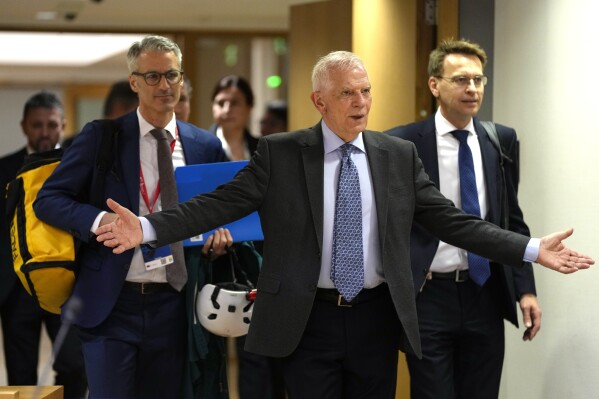
1 of 3 |
European Union foreign policy chief Josep Borrell arrives for a meeting of EU foreign ministers at the European Council building in Brussels, Monday, March 18, 2024. European Union foreign ministers on monday will discuss Russia’s aggression against Ukraine, Belarus, and the situation in the Middle East. (AP Photo/Virginia Mayo)
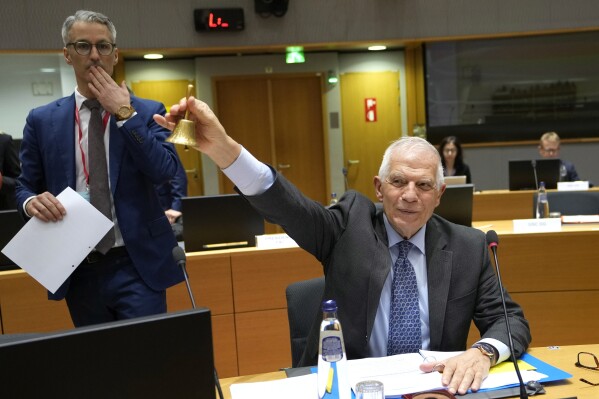
2 of 3 |
European Union foreign policy chief Josep Borrell rings a bell to signify the start of a meeting of EU foreign ministers at the European Council building in Brussels, Monday, March 18, 2024. European Union foreign ministers on monday will discuss Russia’s aggression against Ukraine, Belarus, and the situation in the Middle East. (AP Photo/Virginia Mayo)

3 of 3 |
European Union foreign policy chief Josep Borrell arrives for a meeting of EU foreign ministers at the European Council building in Brussels, Monday, March 18, 2024. European Union foreign ministers on monday will discuss Russia’s aggression against Ukraine, Belarus, and the situation in the Middle East. (AP Photo/Virginia Mayo)
BY LORNE COOK
Updated 3:46 PM GMT+2, March 19, 2024
BRUSSELS (AP) — The European Union is pressing ahead with a plan to use the profits generated from billions of euros of Russian assets frozen in Europe to help provide weapons and other funds for Ukraine, a senior official said Tuesday.
EU foreign policy chief Josep Borrell got a green light for the plan from most of the bloc’s foreign ministers this week, and he hopes that EU leaders will endorse it at a summit in Brussels starting on Thursday. The move comes as Ukraine runs dangerously low on munitions, and U.S. efforts to get new funds for weapons have stalled in Congress.
The 27-nation EU is holding around 200 billion euros ($217 billion) in Russian central bank assets, most of it frozen in Belgium, in retaliation for Moscow’s war against Ukraine. The bloc estimates that the interest on that money could provide around 3 billion euros ($3.3 billion) each year.
“The Russians will not be very happy. The amount of money, 3 billion per year, is not extraordinary, but it is not negligible,” Borrell told reporters.
A small group of member countries, notably Hungary, refuse to supply weapons to Ukraine, so these windfall profits would be divided up. Around 90% of the money would be put into a special fund that many EU countries already use to get reimbursed for arms and ammunition they send.
The other 10% would be put into the EU budget to help bolster Ukraine’s defense industry. Countries that object to sending weapons could then claim that they are not arming the country, Borrell said.
The EU budget can’t be used to buy arms, under current expert interpretations of the bloc’s treaties, but the special fund — known as the European Peace Facility — runs off-budget and doesn’t have to respect the same legal standards or be approved by the European Parliament.
The European Central Bank, or ECB, has warned in the past against seizing Russian assets as this could undermine confidence in the euro currency and EU markets. But Borrell said that no assets would be taken, only the windfall profits they make. He added that the ECB has been consulted on the plan.
Some EU leaders, including Belgian Prime Minister Alexander De Croo, have said that they want to use the windfall profits to fund Ukraine’s reconstruction, but Borrell said he believes that “the best thing is to avoid that anything is destroyed” in the first place.
___
Follow AP’s coverage of Russia’s war in Ukraine at https://apnews.com/hub/russia-ukraine
-
Millaisesta summasta voisi olla kyse? Artikkelin mukaan noin 3 miljardia euroa eli 3,3 miljardia dollaria per vuosi.
Ei siis sinänsä maata mullistava summa mutta kyllä tuolla summalla ostaa jo jotain.
Mitä tuolla summalla voisi saada? Ainakin Tsekin presidentin tuoreen kertoman mukaan maailmalta oli löydettävissä ja ostettavissa 1,5 miljoonaa tykistön laukausta ja tämän hinta oli 3,3 miljardia dollaria. LÄHDE
Jos oletetaan että hinta pysyisi samansuuruisena, silloin ryssältä takavarikoitu potti voisi tukea Ukrainan taistelua 1,5 miljoonan tykistön laukauksen verran per vuosi (kaikki muu tuki ja Ukrainan omat ostokset toki tämän päälle).
Toki pitää muistaa: asiasta keskustellaan, mitään ei ole vielä päätetty.
ido59
Majuri
Mick Ryan aprikoi twitterissä ryssän sotastrategiaa tänä vuonna
The Putin re-election campaign is now complete. What might this mean for Russian military #strategy as we shift into the northern spring and summer? 1/22
2/ Clearly, the main effort will remain its campaign to subjugate Ukraine by degrading and destroying its tactical forces, conducting strike operations against operational, strategic and civilian targets, and its ongoing diplomatic and strategic influence operations.
3/ For several months, the Russians have been conducting tactical actions to advance in the east and south of #Ukraine. Some are opportunistic, taking advantage of Ukrainian force / arty shortfalls and terrain.
4/ Others are deliberate attempts to retake ground lost in Ukrainian offensives in 2022 and 2023. The overall effect however is a massive operational level collection effort to ascertain Ukrainian physical / EW force dispositions, strengths, as well as reserve locations & sizes.
5/ Coupled with extensive aerial and satellite recon, these offensive operations will also be developing for the Russians a broader picture of Ukraine’s current efforts to construct defensive lines across the front line.
6/ They will also correlate this with how their own defensive lines worked, and where they didn’t, in the south. In this process, they may be adapting doctrine and training to attempt more successful ‘break in’ and ‘break through’ operations for their soldiers.
7/ It is prudent to make this assumption. Russia has shown the ability to learn & adapt, even if it is slow & uneven. They will have watched the failure of Cold War NATO doctrine (and inability to coordinate higher level combined arms) in the 2023 Ukrainian counteroffensive.
8/ Concurrently, Russia will be building up munitions stockpiles, and continue using its glide bombs and UAV/FPV operations to support current and future ground operations.
9/ None of the current Russian operations are at the scale, or appear designed, to achieve a significant breakthrough of Ukrainian defenses. Military organisations must ‘fight for information’ in order to ‘fight with information’.
10/ The Russians probably also appreciate that 2024 represents their best opportunity to conduct another large scale offensive against Ukraine. With Ukraine’s personnel and munitions shortages, Russia probably assesses Ukraine’s defensive capacity is at a low ebb.
11/ There are some strategic enablers which Russia will need to get right before any larger ground offensive however.
12/ First, it needs to probably undertake another large scale mobilization to provide a pool of replacements. Any large offensive will inevitably result in large casualties given the Russian style of fighting. And Ukraine’s excellence at killing Russians.
13/ Second, it will need to build up munitions through indigenous production and imports from countries like North Korea. Big offensives are big consumers of munitions.
14/ Third, it will need to somehow address its problem with AFV production and supply. While it has thousands of old vehicles in storage, the more it draws on this, the older the vehicles are and harder to recondition.
15/ Fourth, it will need to address Ukraine’s integrated air, missile and drone defence network which continues to improve. The arrival of F16s will complicate Russia’s challenge in this regard. And they will need to continue to adapt to Ukrainian drone operations.
16/ Fifth, Russia must degrade Ukrainian tactical and operational collection efforts to generate uncertainty and hopefully (for Russia), surprise. It can’t do much about Euro/US surveillance satellites however and the sharing of intelligence gleaned from them.
17/ Russia’s strategic and operational deception may be vital. This was missing from the 2023 Ukrainian counteroffensive. Surprise is harder to achieve with the modern integrated civil-military sensor nets. But it is not impossible.
18/ Sixth, the Russians may be thinking about ‘what happens if a major offensive is successful’? For example, might it prompt a greater NATO intervention? Or, might it lead to a crisis of confidence in western capitals they can exploit?
19/ An inevitable part of Russia’s approach over 2024 will be nuclear threats. It is almost instinctive for them to apply the ‘escalate to de-escalate’ method to deter greater NATO involvement. That said, Putin recently noted that NATO already has ‘boots on the ground’.
20/ Putin’s speeches and comments this year indicate he is willing to double down on his subjugation of #Ukraine. Now his ‘election’ is out of the way, he can dedicate more time and resources to that end.
21/ This thread provides assumptions and a worst case scenario on how the Russian strategy for 2024 in #Ukraine might play out.
22/ It is up to the west to ensure it provides all necessary support now to defend Ukraine in 2024 as it reconstitutes forces, and as the west rebuilds its industrial capacity to match the current production of the ‘arsenal of authoritarians’. End.
The Putin re-election campaign is now complete. What might this mean for Russian military #strategy as we shift into the northern spring and summer? 1/22
2/ Clearly, the main effort will remain its campaign to subjugate Ukraine by degrading and destroying its tactical forces, conducting strike operations against operational, strategic and civilian targets, and its ongoing diplomatic and strategic influence operations.
3/ For several months, the Russians have been conducting tactical actions to advance in the east and south of #Ukraine. Some are opportunistic, taking advantage of Ukrainian force / arty shortfalls and terrain.
4/ Others are deliberate attempts to retake ground lost in Ukrainian offensives in 2022 and 2023. The overall effect however is a massive operational level collection effort to ascertain Ukrainian physical / EW force dispositions, strengths, as well as reserve locations & sizes.
5/ Coupled with extensive aerial and satellite recon, these offensive operations will also be developing for the Russians a broader picture of Ukraine’s current efforts to construct defensive lines across the front line.
6/ They will also correlate this with how their own defensive lines worked, and where they didn’t, in the south. In this process, they may be adapting doctrine and training to attempt more successful ‘break in’ and ‘break through’ operations for their soldiers.
7/ It is prudent to make this assumption. Russia has shown the ability to learn & adapt, even if it is slow & uneven. They will have watched the failure of Cold War NATO doctrine (and inability to coordinate higher level combined arms) in the 2023 Ukrainian counteroffensive.
8/ Concurrently, Russia will be building up munitions stockpiles, and continue using its glide bombs and UAV/FPV operations to support current and future ground operations.
9/ None of the current Russian operations are at the scale, or appear designed, to achieve a significant breakthrough of Ukrainian defenses. Military organisations must ‘fight for information’ in order to ‘fight with information’.
10/ The Russians probably also appreciate that 2024 represents their best opportunity to conduct another large scale offensive against Ukraine. With Ukraine’s personnel and munitions shortages, Russia probably assesses Ukraine’s defensive capacity is at a low ebb.
11/ There are some strategic enablers which Russia will need to get right before any larger ground offensive however.
12/ First, it needs to probably undertake another large scale mobilization to provide a pool of replacements. Any large offensive will inevitably result in large casualties given the Russian style of fighting. And Ukraine’s excellence at killing Russians.
13/ Second, it will need to build up munitions through indigenous production and imports from countries like North Korea. Big offensives are big consumers of munitions.
14/ Third, it will need to somehow address its problem with AFV production and supply. While it has thousands of old vehicles in storage, the more it draws on this, the older the vehicles are and harder to recondition.
15/ Fourth, it will need to address Ukraine’s integrated air, missile and drone defence network which continues to improve. The arrival of F16s will complicate Russia’s challenge in this regard. And they will need to continue to adapt to Ukrainian drone operations.
16/ Fifth, Russia must degrade Ukrainian tactical and operational collection efforts to generate uncertainty and hopefully (for Russia), surprise. It can’t do much about Euro/US surveillance satellites however and the sharing of intelligence gleaned from them.
17/ Russia’s strategic and operational deception may be vital. This was missing from the 2023 Ukrainian counteroffensive. Surprise is harder to achieve with the modern integrated civil-military sensor nets. But it is not impossible.
18/ Sixth, the Russians may be thinking about ‘what happens if a major offensive is successful’? For example, might it prompt a greater NATO intervention? Or, might it lead to a crisis of confidence in western capitals they can exploit?
19/ An inevitable part of Russia’s approach over 2024 will be nuclear threats. It is almost instinctive for them to apply the ‘escalate to de-escalate’ method to deter greater NATO involvement. That said, Putin recently noted that NATO already has ‘boots on the ground’.
20/ Putin’s speeches and comments this year indicate he is willing to double down on his subjugation of #Ukraine. Now his ‘election’ is out of the way, he can dedicate more time and resources to that end.
21/ This thread provides assumptions and a worst case scenario on how the Russian strategy for 2024 in #Ukraine might play out.
22/ It is up to the west to ensure it provides all necessary support now to defend Ukraine in 2024 as it reconstitutes forces, and as the west rebuilds its industrial capacity to match the current production of the ‘arsenal of authoritarians’. End.
Oheisella videolla ryssätankki ampuu mäsäksi siviilien taloja ryssälässä. Ihan sama meininki siis omassa maassaankin. Kaikki pitää paskoa kun paskomaan päästään. Varokaa vain ettette ammu kaikkia taloissa olevia pesukoneita paskaksi. Säästäkää vähän kotiinvietäväksi.
Venäläiskylä Ukrainan rajalla murjottu – suivaantunut paikallinen kuvasi videon: "V*tun tähden"
Venäjän Belgorodin alueelta kuvattu video näyttää, kuinka Kozinkan kylä on runneltu pahanpäiväisesti.www.mtvuutiset.fi
Sitä vielä moni ryssä ihmettelee samaan tapaan...Todellisuus lyö päin kasvoja, ja kysytään vielä moneen kertaan ihmetellen...
Sitä saa mitä tilaa, nyt alkaa maksun aika "kolmen päivän erikoisesta".
tulikomento
Supreme Leader
Oheisella videolla ryssätankki ampuu mäsäksi siviilien taloja ryssälässä. Ihan sama meininki siis omassa maassaankin. Kaikki pitää paskoa kun paskomaan päästään. Varokaa vain ettette ammu kaikkia taloissa olevia pesukoneita paskaksi. Säästäkää vähän kotiinvietäväksi.
Muistelen että ekan Tsetsenian sodan aikana kun Grozny oli piiritettynä, ampuivat ryssät surutta tykistöllä myös niitä kaupungin kortteleita, joissa asui etnisiä venäläisiä. Eli ihan perusryssää. Paskat välitetään omistakin.


